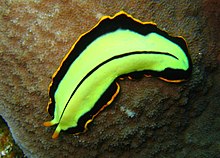
Pseudocerotidae is a family of flatworms which includes the Bedford's flatworm. Pseudocerotidae are simple organisms categorized by their oval bodies and tentacles and bright colors. They use the cilia to glide along surfaces. Most commonly referred to as marine flatworms, closely related to the orders Macrostomorpha and Lecithoepitheliata. These organisms have very complex reproductive systems, no blood systems or organs for gas exchange, a simple brain and are hermaphroditic.
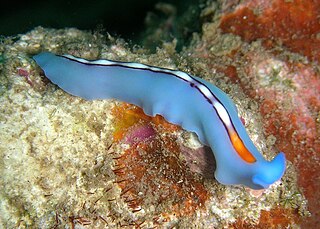
Pseudoceros is a genus of the flatworms Platyhelminthes.

The slippery dick is a species of wrasse native to shallow, tropical waters of the western Atlantic Ocean.
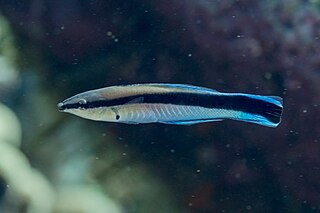
The bluestreak cleaner wrasse, Labroides dimidiatus, is one of several species of cleaner wrasses found on coral reefs from Eastern Africa and the Red Sea to French Polynesia. Like other cleaner wrasses, it eats parasites and dead tissue off larger fishes' skin in a mutualistic relationship that provides food and protection for the wrasse, and considerable health benefits for the other fishes.

Pseudobiceros hancockanus is a species of hermaphroditic marine flatworm in the family Pseudocerotidae. It is also known as Hancock's Flatworm.

Sea anemones are a group of predatory marine invertebrates constituting the order Actiniaria. Because of their colourful appearance, they are named after the Anemone, a terrestrial flowering plant. Sea anemones are classified in the phylum Cnidaria, class Anthozoa, subclass Hexacorallia. As cnidarians, sea anemones are related to corals, jellyfish, tube-dwelling anemones, and Hydra. Unlike jellyfish, sea anemones do not have a medusa stage in their life cycle.

Spawn is the eggs and sperm released or deposited into water by aquatic animals. As a verb, to spawn refers to the process of freely releasing eggs and sperm into a body of water ; the physical act is known as spawning. The vast majority of non-mammalian, non-avian and non-reptilian aquatic and/or amphibious lifeforms reproduce through this process, including the:

Genicanthus bellus, the ornate angelfish, bellus angelfish or bellus lyretail angelfish, is a species of marine ray-finned fish, a marine angelfish belonging to the family Pomacanthidae. It is found in the Indo-Pacific region.

Pseudobiceros bedfordi is a species of flatworm in the family Pseudocerotidae.
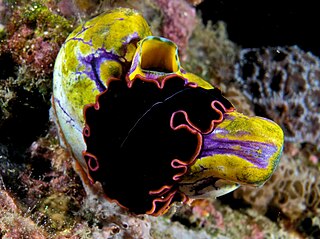
Pseudobiceros gloriosus is a benthic marine flatworm species that belongs to the Pseudocerotidae family. It is typically found in the tropical Indo-Pacific, from Eastern Africa to Micronesia, in the top or slope of reefs. It can be up to 3 in. (7.6 cm.) in length, and feeds on a multitude of invertebrates as gastropods and small crustaceans by engulfing their prey whole.

Pseudoceros bifurcus is a marine flatworm species that belongs to the family Pseudocerotidae.

Pseudoceros ferrugineus, the Fuchsia flatworm, is a marine flatworm species that belongs to the Pseudocerotidae family.
Pseudoceros goslineri, the Gosliner flatworm, is a marine flatworm species that belongs to the family Pseudocerotidae.
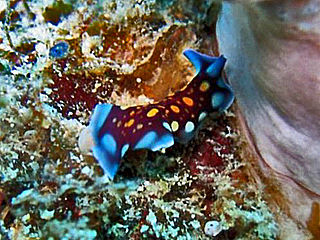
Pseudoceros lindae, common name Linda's flatworm, is a marine Flatworm species that belongs to the Pseudocerotidae family.

Pseudoceros monostichos is a marine flatworm species that belongs to the Pseudocerotidae family.
Pseudoceros scriptus is a marine flatworm species that belongs to the Pseudocerotidae family. This species is commonly known as the script flatworm.

Pseudoceros susanae is a marine flatworm species that belongs to the Pseudocerotidae family.

Prostheceraeus vittatus, the candy striped flatworm, is a species of marine polyclad flatworm in the family Euryleptidae. It is found in Western Europe, including on the western coasts of the British Isles.
Pseudoceros canadensis, commonly known as the Puget flatworm, is a species of free-living flatworm in the genus Pseudoceros, belonging to the family Pseudocerotidae.
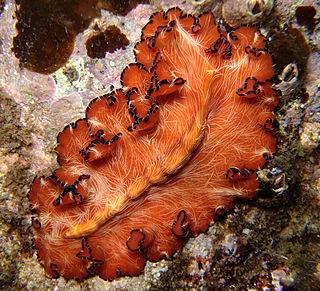
Pseudobiceros fulgor, also known the lightning worm, is a species of marine flatworm from the family Pseudocerotidae and belongs to the class Turbellaria. These flatworms are commonly found in the tropics of the Indo-Pacific region. They can be found in shallow coral reef environments.
